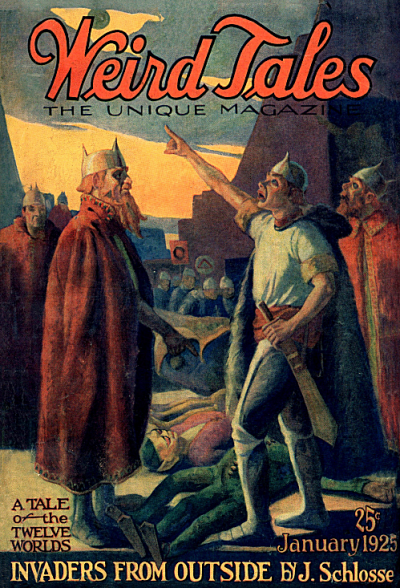INVADERS FROM OUTSIDE (5)
By:
October 7, 2023

J. Schlossel’s first story, “Invaders from Outside,” appeared in the January 1925 issue of Weird Tales. It was one of only six stories that he’d publish. SF historians agree that — with its solar system of inhabited planets, a council of worlds, and a space battle between fleets of ships — the story is an early example of “space opera.” HiLoBooks is pleased to serialize it here for HILOBROW’s readers.
ALL INSTALLMENTS: 1 | 2 | 3 | 4 | 5 | 6 | 7 | 8 | 9.
The instruments that had been brought to bear upon this new member showed that the snowlike substance that covered its surface was quickly evaporating under the warm, kindly glow emanating from old dying Neptune. In a little while all the snowlike substance had evaporated. It had turned into an almost transparent envelope of heavy, bluish gas.
The surface under the covering was then seen for the first time by the observers on the Twelve Confederate Worlds. Nearly the entire area of this new world was covered with square or oblong structures. In some places the square structures had been concentrated for reasons that were as yet unknown. In those places the foundations were truly massive; the structures had been built in tiers, each succeeding tier smaller than the one beneath it; and up, up they went until they formed pyramidal structures several miles in height.
Strange creatures that walked erect on only two feet next made their appearance. The inhabitants of the twelve worlds marveled. The two-legged creatures moved here and there, also seeing, it seemed, the surface of their world for the first time. They must have come up from beneath the surface. They were clad in a uniform, gray, hairy material that hung loosely upon their frames. Their movements were at first listless, but gradually they began to quicken. They looked around for a while and then went below the surface again.
It was not until the next day that they really began to come up in numbers. For the two succeeding days they poured up in a constant stream. In a little while the surface of their world was black with them. They must have hollowed out the very bowels of the planet to have accommodated such vast numbers. Like bees in a hive they were now swarming over their huge pyramidal structures and the smaller oblong buildings, everywhere.
The Scientific Society now realized that it had not been blind chance that had steered this body toward the solar system. It was evident that those intelligent creatures had directed their world to this, a more favorable location.
Realizing that these creatures were intelligent, and thinking that they would probably need and appreciate aid after their long journey, the Twelve Confederate Worlds generously sent out a delegation to the newcomer to inquire if they could be of any assistance. Form or color meant nothing to the inhabitants of those twelve civilized worlds; it was intelligence that they held in high esteem.
No sooner did the party from the Confederate Worlds land than they were surrounded and killed! Neither a reason nor a warning had been given. They were filled with about as much compunction as one would kill some loathsome insects. After killing them, these strange two-legged creatures were seen to go about their tasks as if nothing had happened.
The inhabitants of the twelve worlds were startled, horrified. They actually did not know what to do. The act had no precedent in all their histories. Something must be done. But what? A reprisal? They did not even think of a reprisal, for they were essentially a peace-loving folk. It was unwise to send out another delegation to demand an explanation. They tried every means of interplanetary communication, but they elicited no response.
A few hours after the killing, a group of those strange creatures, but evidently in high command (for they were dressed in a bright red instead of the usual gray, and the gray-clad creatures prostrated themselves whenever the red-clad group came near them), had come up to view the remains of the slaughtered delegation. They were seen to question in turn those who killed them. Those questioned were seen to point up toward the sun, and toward the Twelve Confederate Worlds. The red-clothed were next seen to go over and examine the interplanetary vehicle that the delegation from the twelve worlds had arrived in.
After the event of the red-clothed group the inhabitants of this strange world were seen to start building some new huge pyramidal structures and repairing the old ones.
Always before had it been the Confederate Worlds who were the masters of every situation, but now they were plainly bewildered. They decided to bide their time and wait. They did not fear the invader. It was quite a different matter, this killing of a few unsuspecting individuals, from attacking the twelve civilized worlds.
RADIUM AGE PROTO-SF: “Radium Age” is Josh Glenn’s name for the nascent sf genre’s c. 1900–1935 era, a period which saw the discovery of radioactivity, i.e., the revelation that matter itself is constantly in movement — a fitting metaphor for the first decades of the 20th century, during which old scientific, religious, political, and social certainties were shattered. More info here.
SERIALIZED BY HILOBOOKS: James Parker’s Cocky the Fox | Annalee Newitz’s “The Great Oxygen Race” | Matthew Battles’s “Imago” | & many more original and reissued novels and stories.
